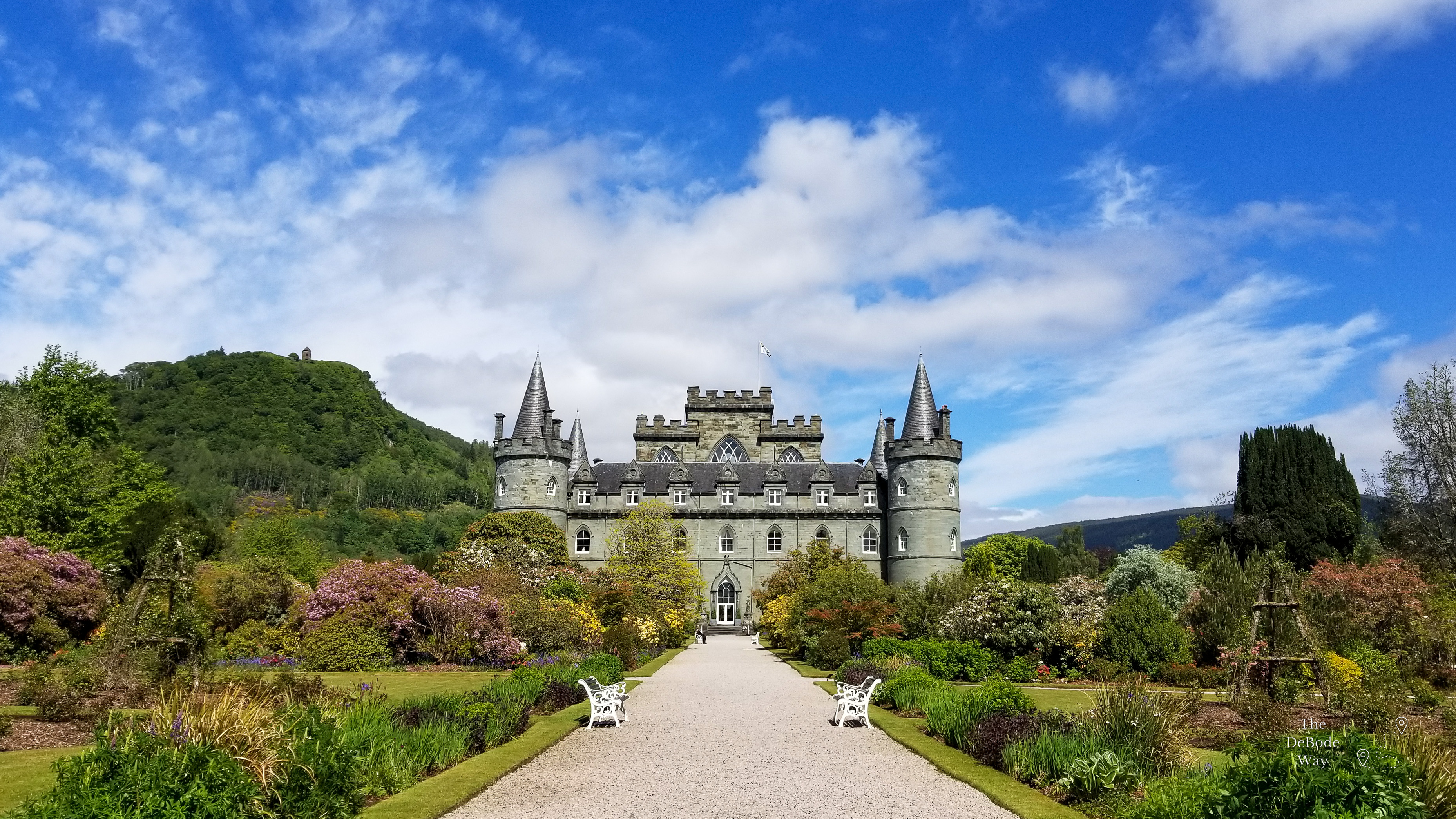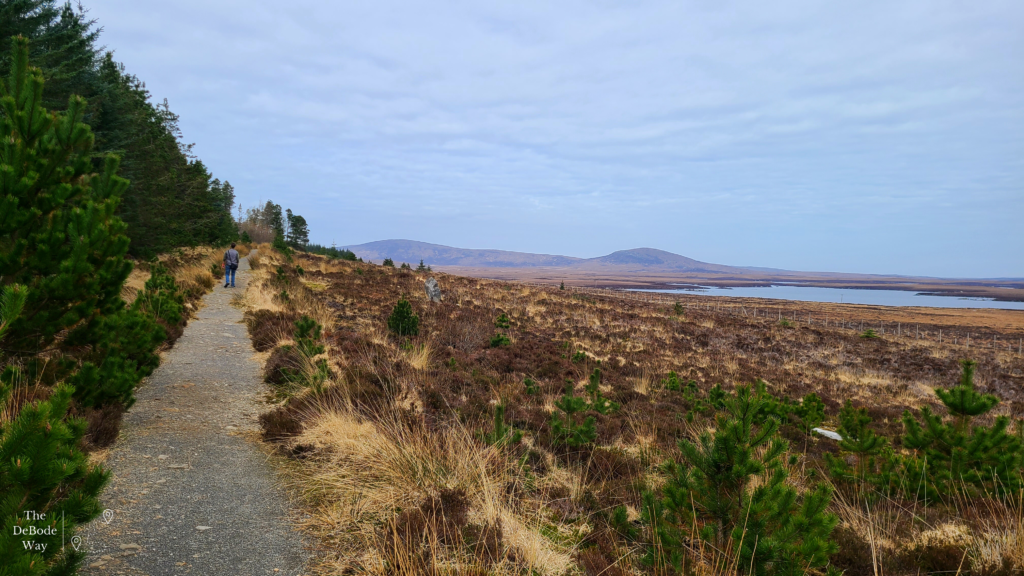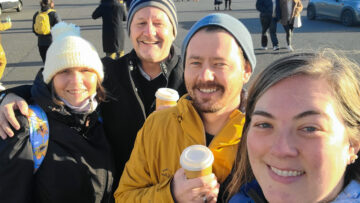We’re back with part 2 of our FAQs about traveling in Scotland. Let’s get into the nitty gritty.

FAQ 7: What do I need to pack for my trip?
This is hard to answer because it depends on when you’re going, where you’re going, what you plan to do, whether you’re packing in carry-ons or checked bags, and your personal preference. That said, we have a few rules we stick to when packing for Scotland. First, layers are your friend. Like I said above, it’s entirely possible for a brief rain shower while you’re out exploring. The same is true for temperatures: it can start off very chilly in the morning, warm up throughout the day, and then cool off again in the evenings. Because of this, it’s really helpful to have lighter-weight layers you can add/remove as you go about your day. It’s also very helpful if your outermost layer is waterproof.
Few pieces of clothing are as iconic as the thick, heavy, knit wool sweaters you see people wearing in the movies. It’s true that folks living in the UK really do wear those sweaters, too. We’ve brought a few back and absolutely love them. Do we take them back when we travel? Absolutely not. Why? Because they’re designed to hold in your body heat, and they’re very good at what they do. Unfortunately, if that’s all you’re wearing (with a t-shirt underneath), and the day starts to warm up, you’ll likely be sweating before long with no layers to remove. That can make things uncomfortable, and no one wants that. Also, one of those sweaters can easily take up half of your carry-on bag, which is a non-starter for us.
So, take thinner layers (big fans of Merino wool) and a windproof/waterproof jacket and shoes. We usually dress pretty casually during the day, but that’s because we’re usually out hiking or exploring. If we stayed in the city, we’d likely stick closer to something like smart casual, or thereabouts. For dinner, we pack something a little nicer: a dress and flats for Tasha, and chinos with a button-down shirt for Jason. Also keep in mind that because the climate is a bit cooler, unless you’re doing some really intense hiking, it’s likely that you won’t sweat much (again, everyone is different, but in general), so you can re-wear some of your clothes before needing to wash them. Except for your socks and underwear; those will always need to be washed before you wear them again. Otherwise…gross.
Since we are carry-on only packers most of the time, we like to try to pack for 4 days with plans to do laundry either at a facility or in our bathroom sink/tub whenever we’re in a location for a couple days so it has time to dry.

FAQ 8: What’s with all the castles?
Who doesn’t like a good castle? Jason raises his hand. Okay fine, yes there are lots of castles in Scotland and the UK. Some are ruins, some are in various stages of (dis)repair, and others are fully working homes (with huge maintenance bills) that allow visitors in for a fee. Some are large, some are small. Some are situated in easily defended positions, while others seem to be sitting in the middle of a field.
Why are there so many? In fairness, they’ve been building them for a long time. A really long time. By some accounts, they’ve been building stone castles in Scotland since the 11th century (wood before that), the majority of which were built for those who governed the lands. Not to be outdone, the nobles also built castles, though these were mostly referred to as tower houses rather than castles. Then, of course, came the palaces of the kings and queens of Scotland and the various nations that ruled it throughout the centuries. These are more pleasure homes for peace times than defensive structures, but very impressive as well. And of course, when a new ruler took the throne, why would they want to live in someone else’s house? Much better to build their own, and build it better/bigger. Obviously. And so, Scotland, and many other European countries are peppered with castles of all shapes, sizes, and ages.

FAQ 9: What’s the bathroom situation?
We’ll put this one to rest: yes, they have bathrooms in Scotland. However, you might get a funny look asking for the bathroom – they generally just call it what you’re after, the toilet.
Seriously though, most of the time we get this question in reference to being out and about, driving around, away from civilization. In the US, when you go on a road trip there is almost always a fast food restaurant, gas station, rest stop, or a combination of the three at the next exit. So, when nature calls, you’re rarely that far from the facilities. Unfortunately, this isn’t always the case in Scotland. It’s totally common to drive for hours without seeing a single sign for a restroom. And, if you get daring and take the next exit despite there being no sign, it could be a while before you actually get to a town, and even then, there might not be a gas station with a toilet or public toilets and the pub might be closed until the next meal service.
This isn’t to suggest rest stops don’t exist in Scotland because they absolutely do. However, this is one of those situations where it’s better to take a look at your route in advance and know where you can stop. This also applies to gas stations (usually called petrol stations throughout the UK), which are nowhere near as omnipresent as they are in the US. There are also apps (Where is Public Toilet app) you can download that’ll help guide you in the right direction. Also, be advised that some public toilets aren’t free. Some require a coin to get in, while others will take a credit card, but only one that has the tap functionality. And you might want to keep a roll of TP or some tissues with you just in case – they aren’t usually overly stocked.
Basically, if you find one, take advantage! If not well…find a bush, dig a hole, and practice your best farmer’s squat…more on that here.

FAQ 10: How do you take all those great pictures? Is trespassing not a thing over there?
Yes, trespassing is absolutely a thing in Scotland. At the same time, they have what’s known as the Right to Roam as well. Let’s explain.
In 2003, Scotland passed the Land Reform Act. Section 1 of this Act says that people in Scotland have the right to be on land for recreational and educational purposes and to cross land for the same reasons. What that means is you’re literally able to roam through almost all of Scotland and it’s perfectly legal and normal.
Before we go any further, there are a few really important things to keep in mind about this. First, the Act doesn’t give everyone access to all lands. In general, if it’s private land and is close to a house, farm building, school, or something along these lines, it’s best to keep your distance. In other words, you can walk through a field, but not the yard right next to someone’s house (because…that would be weird). Second, the Act clarifies this is for the ‘responsible’ recreational use of the land. In other words, there might be sheep, cows, or other animals hanging around and it’s best to leave them alone (seriously, do you know how big a Highland Coo is?). Also, don’t leave your trash after you go. In general, a good rule to go by is ‘leave no trace’. In other words, after walking through someone’s land, they shouldn’t be able to tell you were there.
With that all said, yes, you can roam around as much as you like! When we’ve been wandering around fields, there are actually stone stairs built into the stone walls that separate one field from another. These steps are used by the folks out roaming around (and farmers moving between fields) and they help make it easier to gain access to different places. It also means you aren’t climbing on someone’s wall, and therefore helps keep things in good working order. There are also gates that help keep the animals in, but they give you access to different areas. You’re welcome to walk through them, just make sure you close the gate behind you. We’ve gotten some of our best pictures like this, but be advised: there are unlikely to be parking lots anywhere near these fields. Most often, we park a good bit away, and then start hiking in no particular direction.

FAQ 11: Tell me more about the food.
It’s amazing.
One thing we were unprepared for was that what we call fast food in the US isn’t super common in Scotland. To clarify, there are plenty of McDonald’s, Burger Kings, and Subways in the major cities, but as soon as you leave them, don’t expect to find fast food very often. And why would you even look for it? There are loads of places to eat that have fresh, hand-made food that was very likely prepared by someone’s grandmother earlier that day. Seriously, even when you go to a tourist attraction, the food at the cafe is often made from scratch, or at least it always is when we’re there. And yes, vegetables exist.
So, the food really is awesome, but just make sure you’re not expecting to find the US in every little town you visit.

FAQ 12: Is it whiskey? Whisky? Scotch? Bourbon? What’s the deal?
This is a very important cultural question, and it pays to not get it wrong as it’s kind of an insult. This is also best answered in its own post, which I’ll do later, but for now, here are the very high-level details.
Whiskey/Whisky is a more general term for a liquor made from a fermented grain mash. Very broadly speaking, there are different grains that can be used, and the spirit is typically aged in wooden casks for a certain period of time. As for the spelling, whiskey is most often used in Ireland and the US; whisky is the preferred spelling everywhere else.
Bourbon is a whiskey that, by law, must be distilled in the US, must use a grain mixture that is mostly corn, is aged in new charred oak barrels, and is bottled at 80 proof or higher. Common lore insists that bourbon must be distilled in Kentucky, but as far as we can tell, so long as it’s distilled in the US, it can legally be called bourbon.
Scotch is a whisky that, by law, must be distilled in Scotland, is at least 80 proof, includes only water, malted barley, and yeast, and is aged for a minimum of three years in oak barrels. A few things to clarify: Scotch can include other cereal grains but the malted barley still has to be there. The law only states that the spirit is aged in oak barrels, but unlike bourbon, they need not be new barrels. Interestingly, this has led to a secondary market for US bourbon barrels. After they are used in the US, they’re often shipped to Scotland, taken apart, adjusted, reformed, and charred for use in aging Scotch. Broadly, Scotch tends to come in two forms: single malt or blended. Single malt Scotch is from a single batch from a single distillery and must use only water, malted barley (no other grains can be added), and yeast. Blended Scotch, on the other hand, is, as the name suggests, a blend of different types of Scotch (i.e., malt and grain whisky); the spirits are blended to create a more consistent product.
These are painfully broad details because there are all kinds of nuances within each category. My two cents: I only drink Scotch and bourbon. I’ve tried Irish and Japanese whiskeys, and with all respect to the distilleries, they just aren’t my preference. Want something that’ll burn (in all the best ways) while you drink it? Go for bourbon. Want something smoother that’ll be pretty much the same anywhere and whenever you get it? Blended Scotch would be my recommendation. Want something a little more subtle, sometimes smokey, sometimes sweet, sometimes both? Something with more character, but one that might change from year to year? Single malt all the way. Want more specific recommendations? Great, let’s talk.

FAQ 13: How does it work with your drone?
Good question. Yes, we have a drone. Yes, we take it to Scotland every time we go. Yes, Jason is also licensed to fly it in the UK. This last part is really important.
In the US, if you want to fly your drone, you need to register it with the FAA. And so it is with every other country in the world. When we’re off to a new country, one of the first things Jason does is a little searching to see what, if any license he needs to fly the drone. Most often, it’s an operator license that’s very similar to the one he has here in the US. Read the book, take the online training, pass the quiz, pay the fee, and you’re good to go. Most countries require you to have your operator license number physically on the drone (we have a sticker with the info), and you have a physical copy of your license (we have them printed out and keep them in our drone case). Most countries are pretty similar with regard to the rules (e.g., don’t fly your drone in cities, near airports, over people, etc.), but there is some variability with regard to your flight ceiling (the highest you can take your drone) and a few other things.
Can you fly your drone without a license? Sure. Would we recommend it? No. If something goes wrong and you get to meet the local police, odds are they’ll confiscate your drone and make you pay a fee. Don’t risk it; getting the license really isn’t that big of a deal. Oh, and yes, you’ll need to do this for each country; sadly there’s no EU-wide license, at least not as of now.





